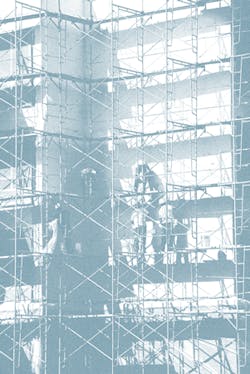Hidden Risks in the Current Construction Environment
By Paul E. Himes
Up. Down. Up. Down. Flat. Which way are construction prices going? Polish up that crystal ball or find, in Harry Truman's famous words, that ever-elusive one-handed economist.
Copper, aluminum, steel, and other strategic metals prices have all gone through the roof during the last several years. (Nice if you own commodity stocks, but not so nice if you're buying construction contracts.) Drywall went from expensive and scarce to plentiful and easy to obtain. Site-work guys? "Forget about it" was the response 2 years ago when trying to get a quote or firm price and manpower, and now they're calling and begging to put their equipment to work. (Thank you, residential slowdown.)
As they try to find good news for their budgets and job-cost forecasts, owners frequently ask, "Aren't construction costs going down?" The answer is an absolute, definite "maybe." If you're doing a project that's very site-work intense with less skilled labor, such as a warehouse, then the answer is "yes." If you're doing a Tier 3 data center with miles and miles of copper and aluminum cable, highly sought-after and in-demand generators, as well as sophisticated building-control systems, then the answer is "no."
In an era where we're being seesawed on pricing, we find ourselves in a very uncertain time for construction-cost forecasting. As recently as 9 months ago, we were using 0.75-percent per month as an overall escalator on square-footage or ROM (Rough Order of Magnitude) costs. Now, it's more like 0.4 to 0.5 percent. And, we're seeing interiors projects that are currently being bid come in 20-plus-percent under 1-year-old and older budgets.
These budgeting and cost-forecasting factors obviously play a role in the construction environment, but the much more insidious aspects of costs and dangers that this market brings us are important, too. General contractors across the land fear the one subcontractor bid on bid day that is unreasonably low—so low that they scratch their heads as to how it could be, yet knowing that their competitors will take that number and use it at bid time, and, if they do not, they will lose the job.
Once a subcontractor takes a job, however, that may only be the beginning of the risks to the owner. Here are some of the risks inherent in subcontracting—especially with ultra-low bids.
Risk No. 1: Subcontractor Default
This is the obvious one. The subcontractor isn't making money, he takes a hit on another job, he starts playing with his sub-subcontractor and materialmen's payments, and, the next thing you know, there are no workers on-site because payroll isn't being made, and the sub defaults.
Mitigation techniques you can use to avoid this situation:
- Require a performance bond and a payment bond from the subcontractor—especially if he's the "How-can-he-do-that-so-low?" bidder. Get the bonds before he starts on the project. And, the old adage holds true here: If he can provide a bond, you may not need one; if he can't provide a bond, you should require one.
- Maintain constant vigilance and inspection. Remember: People don't do what is expected of them, but rather what is inspected.
Risk No. 2: Contractor Default
This is the biggest of all risks. It will not be the first time, or the last, that a general contractor has been taken under by a sub taking a job at a cost that is too low. This is most likely to occur with weaker general contractors. The sub goes under and it costs more to complete the work later with a different sub.
Mitigation techniques you can use to avoid this situation:
- Do a structured prequalification and procurement. Place special emphasis on the bonding rate; their surety will perform much greater financial diligence than you can or will.
- Require a performance bond as well as a payment bond of the contractor (see Risk No. 1).
- Constant vigilance and inspection (see Risk No. 1).
- Pay attention at requisition time. Don't let the general contractor get ahead of you in asking for money. Pay only for work in place that has been documented and inspected.
Risk No. 3: Schedule Delay
This one is like getting pecked to death by ducks: one peck at a time. The subcontractor starts to have payroll problems and starts to short staff the project, and starts to slip behind a little at a time. Project team members make lots of efforts eventually to have them catch up, but things slip and then start to affect other subs, and then the overall schedule.
Mitigation techniques you can use to avoid this situation:
- In addition to requiring a detailed and updated construction/project-management schedule at the outset of the project, require a 4-week-look-ahead schedule at every progress meeting. This makes it easier to track performance (or lack thereof).
- Require a performance bond (see Risk No. 1).
- Constant vigilance and inspection (see Risk No. 1).
- Require that the general contractor supply you with daily superintendent logs.
Risk No. 4: Materials Security
Copper at $4 per pound. Aluminum at $1.30 per pound. These are commonly used materials on construction sites. They're relatively lightweight (ever tried to haul steel I-beams off-site with your station wagon?). And, most importantly, they're easily resold at scrap yards - no questions asked. We are now seeing copper piping being cut out of buildings as fast as it goes in, and copper cables cut out before being energized.
Mitigation techniques you can use to avoid this situation:
- Keep materials responsibility with the subcontractor up until substantial completion. Most contracts do this already, but beware: Subs will be pricing in physical security for this now.
- Consider having the general contractor be responsible for site security: Additional owner costs, yes, but weigh this against the sub providing it or the project taking too long to build.
- Use real video cameras, as well as fake ones, and post security signs at the site.
- Use lots of temporary lighting.
Risk No. 5: Materials Substitution
We are now seeing this start to happen again. Cheaper materials are being installed instead of what was specified and contracted for. The lower the bid, the higher the temptation to substitute (and we're not talking about approved substitutions).
Mitigation techniques you can use to avoid this situation:
- Inspect installed materials for conformance to plans and specs.
- Be certain that you have this responsibility in your A&E and testing and inspection agreements. Make it a positive responsibility of the A&E, not at their discretion.
- Be cautious about paying for off-site stored materials.
Risk No. 6: Increased Claims
In any bid environment, there is always a risk for claims, but most notably in the low-bid, fixed-cost type of contracting. The lower the number used by the sub or general contractor, the more he is going to be looking for discrepancies in the documents or jobsite situations in order to make claims. Many subs take projects on at cost, hoping to make money on claims or changes.
Mitigation techniques you can use to avoid this situation:
- Be certain that your construction documents and specifications are well and tightly coordinated.
- Allow your professionals enough time for quality control and coordination of the documents.
- Be certain that RFIs and submittals are being responded to by your project professionals.
There are entire volumes written about construction risks and how to prevent them. Here, we try to point out either new risks or those that are magnified due to the current pricing environment. So, these thoughts are in addition to the good and proper project-management techniques of contracts, schedules, budgets, etc.
The rewards are great right now if you're an owner/purchaser/user of construction. But, beware: The risks are increasing as well. Be smart and stay ahead of that curve.
Paul E. Himes is president and CEO at Himes Associates Ltd., Fairfax, VA. Himes can be reached at [email protected].



